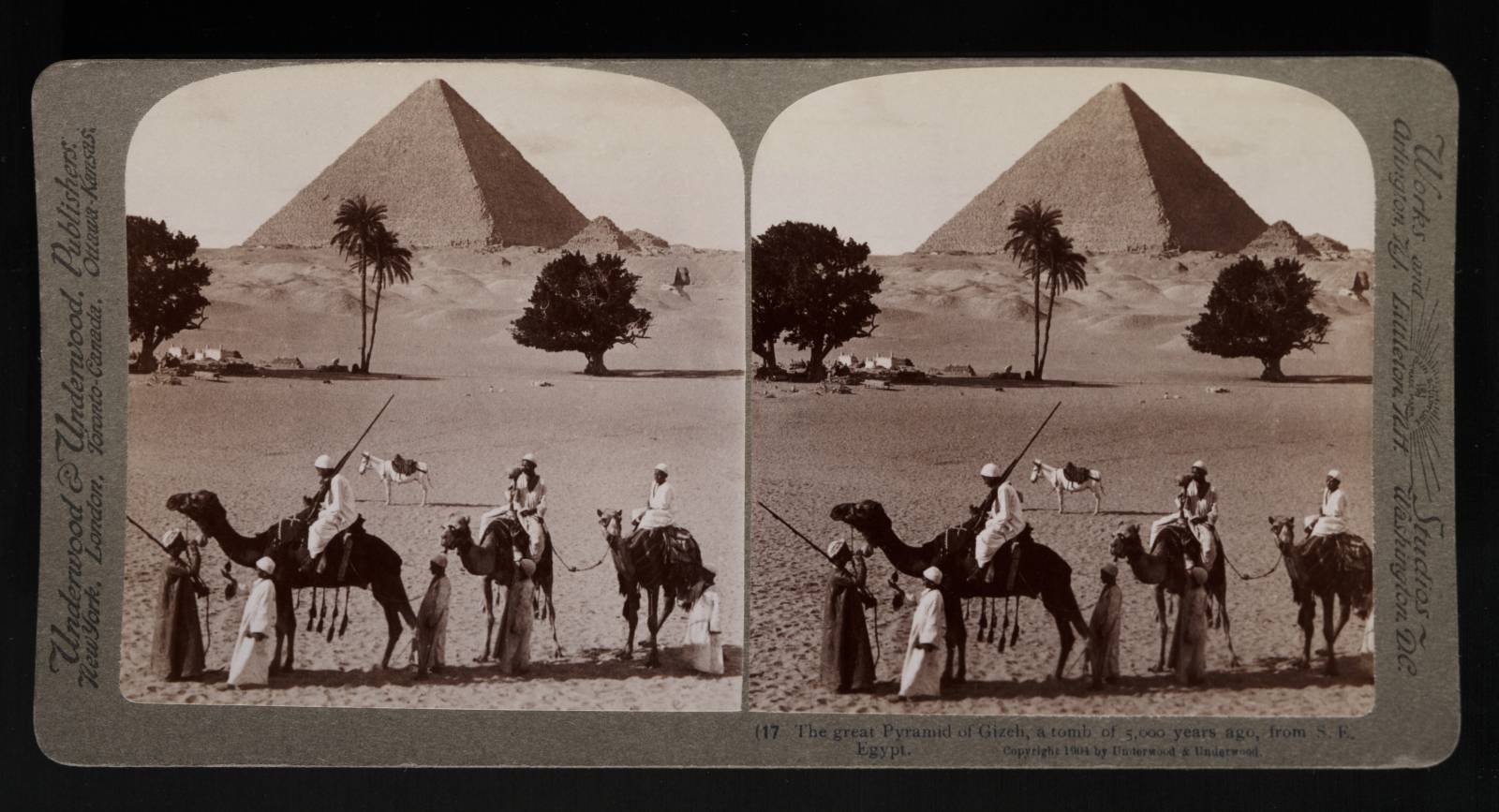Egypt Through The Stereoscope
A Journey Through The Land Of The Pharaohs
by James Henry Breasted | 1908 | 103,705 words
Examines how stereographs were used as a means of virtual travel. Focuses on James Henry Breasted's "Egypt through the Stereoscope" (1905, 1908). Provides context for resources in the Travelers in the Middle East Archive (TIMEA). Part 3 of a 4 part course called "History through the Stereoscope."...
Position 17 - The Great Pyramid Of Gizeh, A Tomb Of 5,000 Years Ago, From The Southeast
 With Cairo on our right and Memphis behind us, we look north-northwestward to the great Pyramid. We stand for the first time on the desert sands. These chattering boys, who clamorously offer us the backs of their camels for a ride over to the Sphinx yonder, will not contribute greatly to the meditative frame of mind, which overtakes one in the presence of such impressive monuments. Behind us, but not within our prospect is a stretch of the ancient wall of the city (see Map 5), which was the royal residence of the king who built yonder gigantic tomb.
With Cairo on our right and Memphis behind us, we look north-northwestward to the great Pyramid. We stand for the first time on the desert sands. These chattering boys, who clamorously offer us the backs of their camels for a ride over to the Sphinx yonder, will not contribute greatly to the meditative frame of mind, which overtakes one in the presence of such impressive monuments. Behind us, but not within our prospect is a stretch of the ancient wall of the city (see Map 5), which was the royal residence of the king who built yonder gigantic tomb.
The three small pyramids beside it probably belong to members of his family, for Herodotus says that the middle one was the tomb of the daughter of Khufu. In a line with these, but nearer to us, rises the gloomy head of the Sphinx, gazing into the rising sun and guarding this city of the dead as he has done these five thousand years perhaps. At the left are the palm-shaded graves of the Moslems, the modern descendants of the very men who inhabited the vanished city that once rose around us. This contrast between the humble sepulchers of the men of yesterday and the vast tombs of their ancestors, is one which is symbolical of the fallen fortunes of the present-day Egyptians, and one which will meet us very often in our voyage up the river.
How much lies between these humble tombs of yesterday and that hoary pyramid! Already to the ancient Greeks it was one of the marvelous survivors of antiquity, which they involuntarily placed among the seven wonders of the world; and although all the others of the seven have passed away and for the most part left no trace, this wonder of all ages still stands— stands as it had stood for some eight hundred years, when Abraham looked across upon it from his Delta pastures; stands as it had done for fifteen hundred years, when the prophet of the Hebrew Exodus led forth his people.
It saw the sword sink from the impotent hand of decadent Pharaohs, till six hundred years later it beheld the fierce soldiery of Assyria scattering ruin and desolation at its feet and plundering glorious Thebes; two centuries more and it beheld the Persian host pouring in through the isthmus like a flood and repeating that desolation; two hundred years later it saw the triumphant entry of Alexander, as he marched beyond it to worship at the desert shrine of Amon; three centuries more and it beheld the legions of Rome, stationed from end to end of this valley and bringing in the new order of the imperial city; seven hundred years more and it saw the wild hordes of Arabia, surging in across the Delta plain, with the breath of the desert hot upon their lips as they brought to the children of the Nile the language and the religion of Mohammed; nine centuries later it saw the baleful gleam of the star and crescent rising in the isthmus and heralding the oppression and misrule that have ever followed the footprints of the Turk; three hundred years more and it shadowed Napoleon as he stood there at its feet, calling upon the soldiers of France to remember the centuries that looked down upon them; and within the memory of almost all who look upon it now, it heard the crack of the British rifles at Tell-el-Kebir.
The whole world-drama from the dawning of the ages until now, has been enacted at its feet; the centuries have clustered like little children around its hoary knees, and it still stands and it is still the wonder of the world.
These are the thoughts of every one who visits this monument to-day; they are commonplace, but who can help renewing them as we stand in the presence of a structure which has lived through the whole span of the historic centuries, to tell of the power and civilization, which prevailed in the days that brought it forth. It has indeed much to tell us, and we must begin its study up on the plateau from which it rises, at the northwest corner, the one diagonally opposite that which is now nearest to us. We are now about 700 feet from its base; our next position will be little over 100 feet. We shall be near enough to see the courses of stone.
